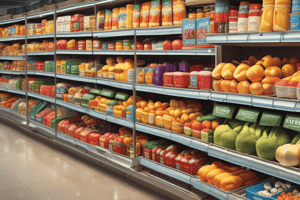Podcast
Questions and Answers
What was a significant contributor to the increase in food prices in the last decade?
What was a significant contributor to the increase in food prices in the last decade?
- Reduced global affluence
- Improved agricultural practices
- Decreased population growth
- Higher agriculture and energy costs (correct)
About how many people are added to the global population annually?
About how many people are added to the global population annually?
- 84 million (correct)
- 200 million
- 57 million
- 141 million
Which of the following factors has contributed to the decline in fertility rates over time?
Which of the following factors has contributed to the decline in fertility rates over time?
- Enhanced availability of contraception (correct)
- Increased mortality rates
- Lack of education
- Economic instability
What trend in mortality rates began in the late 1700s?
What trend in mortality rates began in the late 1700s?
Which of the following is not a factor affecting population growth?
Which of the following is not a factor affecting population growth?
Why do developed countries tend to have lower fertility rates compared to developing countries?
Why do developed countries tend to have lower fertility rates compared to developing countries?
Which of the following impacts food security negatively?
Which of the following impacts food security negatively?
What is the primary reason for the increase in global population according to the data presented?
What is the primary reason for the increase in global population according to the data presented?
What percentage of the Earth's fresh water is available for use?
What percentage of the Earth's fresh water is available for use?
What is the estimated amount of water required to produce food for a family of four for one day?
What is the estimated amount of water required to produce food for a family of four for one day?
Which factor does NOT significantly affect water resources in Lebanon?
Which factor does NOT significantly affect water resources in Lebanon?
What is the volume of water supply needed in Lebanon to meet domestic demand by 2030?
What is the volume of water supply needed in Lebanon to meet domestic demand by 2030?
What percentage of Lebanon's population is urbanized?
What percentage of Lebanon's population is urbanized?
How much water do tourists in Lebanon consume compared to residents?
How much water do tourists in Lebanon consume compared to residents?
What is a consequence of urbanization in Lebanon?
What is a consequence of urbanization in Lebanon?
Which of the following is a key obstacle in managing water resources in Lebanon?
Which of the following is a key obstacle in managing water resources in Lebanon?
What was the prevalence of hunger globally from 1990 to 2015?
What was the prevalence of hunger globally from 1990 to 2015?
According to the latest reports, how many people globally are considered hungry?
According to the latest reports, how many people globally are considered hungry?
Which of the following is NOT one of the elements of the Zero Hunger Challenge?
Which of the following is NOT one of the elements of the Zero Hunger Challenge?
Which demographic region had the highest number of malnourished people during 2014-2016?
Which demographic region had the highest number of malnourished people during 2014-2016?
What is the goal of the Zero Hunger Challenge?
What is the goal of the Zero Hunger Challenge?
When was the Zero Hunger Challenge launched?
When was the Zero Hunger Challenge launched?
What aspect of agricultural land use is expected to change by 2050 in the world?
What aspect of agricultural land use is expected to change by 2050 in the world?
What was the caloric consumption projected to be in 2050?
What was the caloric consumption projected to be in 2050?
What is the primary aim of SDG 2?
What is the primary aim of SDG 2?
Which of the following is NOT mentioned as a requirement for achieving SDG 2?
Which of the following is NOT mentioned as a requirement for achieving SDG 2?
What percentage of the global population was estimated to be hungry in 2014-2016?
What percentage of the global population was estimated to be hungry in 2014-2016?
What does stunting in children indicate?
What does stunting in children indicate?
How many people remain hungry worldwide according to the content?
How many people remain hungry worldwide according to the content?
Which aspect is NOT part of promoting sustainable agriculture?
Which aspect is NOT part of promoting sustainable agriculture?
What is one consequence of inadequate dietary energy access?
What is one consequence of inadequate dietary energy access?
By what year is the 'zero hunger' target expected to be largely missed if current trends continue?
By what year is the 'zero hunger' target expected to be largely missed if current trends continue?
What is one significant environmental benefit of organic agriculture compared to conventional farming?
What is one significant environmental benefit of organic agriculture compared to conventional farming?
How does organic farming impact species diversity relative to non-organic farming?
How does organic farming impact species diversity relative to non-organic farming?
What is a key role of livestock in organic agriculture?
What is a key role of livestock in organic agriculture?
What requirement must be met for organic livestock production?
What requirement must be met for organic livestock production?
What is one consequence of using antibiotics in non-organic livestock farming?
What is one consequence of using antibiotics in non-organic livestock farming?
Which of the following practices contributes to soil stabilization in organic agriculture?
Which of the following practices contributes to soil stabilization in organic agriculture?
What does the presence of genetically modified organisms (GMOs) in agriculture imply for organic farming?
What does the presence of genetically modified organisms (GMOs) in agriculture imply for organic farming?
What impact do pesticides have on wildlife and biodiversity?
What impact do pesticides have on wildlife and biodiversity?
Flashcards are hidden until you start studying
Study Notes
Food Commodity Prices
- Food prices increased and fluctuated in the last decade.
- Factors driving up food prices include climate change, extreme weather, production disruptions, population growth, increased global wealth, and higher agricultural and energy costs.
- The COVID-19 pandemic recovery, global supply constraints due to rising production costs, and the war in Ukraine have further impacted food prices.
- High food prices contribute to poverty, food insecurity, and malnutrition.
Population Growth
- The global population is increasing by approximately 84 million people annually.
- Population growth is affected by birth rates and death rates.
- Improvements in healthcare have lowered death rates.
- Socioeconomic changes have led to lower fertility rates.
Water Issues
- There is a limited supply of fresh water available for use.
- More than 2 billion people lack access to clean drinking water.
- Producing food for a family of 4 for one day requires approximately 25,000 liters of water.
Water in Lebanon
- Water is a crucial resource in Lebanon.
- There is a growing pressure on water resources due to increasing demand from various sectors, unsustainable water management practices, and water pollution.
- Lebanon's water demand is expected to increase significantly in the future.
Factors Affecting Water Resources in Lebanon
- Population growth, including the influx of refugees.
- Urbanization, with an expected expansion of urban areas by 10 km2 per year.
- Economic growth, which is the primary driver of urbanization in Lebanon.
- Climate change.
Future Challenges for Feeding the World
- Projected increases in global population will create challenges for ensuring food security.
- The demand for food will continue to rise.
- There are limitations in the amount of land available for cultivation.
Hunger and Malnutrition
- Despite progress, millions of people remain hungry.
- The number of malnourished individuals has increased.
- The prevalence of hunger has declined from 19% to 11% between 1990 and 2015.
- However, over 828 million people worldwide still face hunger.
- The 'zero hunger' target is likely to be missed by 2030.
Zero Hunger Challenge
- The Zero Hunger Challenge is a United Nations initiative aimed at ending hunger, eliminating malnutrition, and building sustainable food systems.
- It emphasizes five key elements: ending hunger, eliminating all forms of malnutrition, building resilient agricultural systems, promoting sustainable food systems, and fostering a global partnership for sustainable development.
SDG 2: End Hunger and Malnutrition
- Sustainable Development Goal 2 focuses on ending hunger and malnutrition by 2030.
- It aims to ensure universal access to safe, nutritious, and sufficient food.
- Achieving SDG 2 requires sustainable food production systems, equal access to land, markets, international cooperation, and technology to enhance agricultural productivity.
- Nearly one in three children under the age of five suffer from stunted growth.
- The number of overweight children is also increasing.
Organic Agriculture
- Organic agriculture offers environmental and health benefits.
- It reduces greenhouse gas emissions and improves soil health.
- It supports biodiversity and protects wildlife.
- Organic farms have 30% more species on average than conventional farms.
Organic Livestock Production
- Organic livestock are raised using sustainable practices.
- They are fed organically produced feed and have access to grazing areas.
- Genetically modified organisms and chemically synthesized medications are not permitted in organic livestock production.
- Animal welfare is a priority.
- Antibiotics are not routinely used in organic livestock production.
Benefits of Organic Agriculture for Human Health
- Organic farming reduces the use of pesticides and antibiotics, which can have negative impacts on human health.
- Organic foods are generally considered to be healthier and safer.
Studying That Suits You
Use AI to generate personalized quizzes and flashcards to suit your learning preferences.




